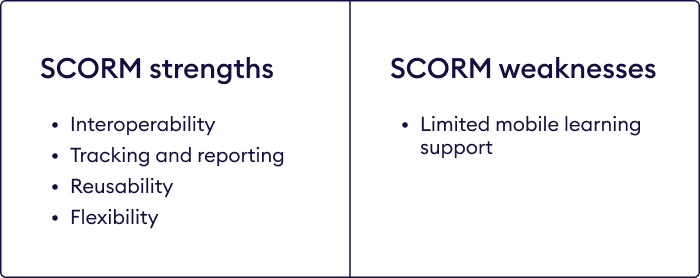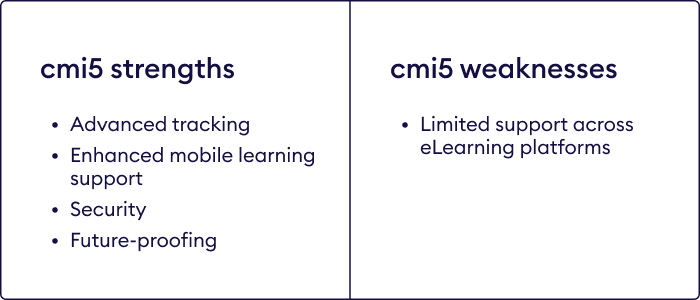cmi5 vs. SCORM: What Is the Difference?

This article will provide a comprehensive comparison of cmi5 and SCORM. You’ll learn about the functionalities, compatibility, as well as the strengths and weaknesses of both standards. Understanding these distinctions will be extremely helpful when developing eLearning content or selecting an LMS for your training projects.
What Is SCORM?
SCORM stands for Sharable Content Object Reference Model. It’s a set of specifications that allows learning content to be created, organized, and shared across different LMSs. This helps ensure that the content works consistently across various platforms and devices.
How does SCORM work?
SCORM facilitates communication and data exchange between a learning course and an LMS. It combines all training materials for a course into a so-called SCORM package, which is a ZIP archive containing files organized in a specific hierarchy. All the content should be combined in this package and stored in the same domain as the LMS.
SCORM consists of three main components working together to deliver courses through an LMS:
- Content packaging. It organizes the course materials into a ZIP file.
- Run-time. It launches the course in a web browser.
- Sequencing. It determines the navigation flow for learners as they progress through the course.

There are three versions of SCORM: 1.1, 1.2, and 2004. SCORM 1.1 was not widely adopted, but SCORM 1.2, released in 2001, remains relevant and widely used. SCORM 2004, introduced in 2004, is now the most commonly used version due to its enhanced features.
SCORM strengths and weaknesses
SCORM has become a widely accepted eLearning standard for several reasons. Let’s delve into its major advantages and limitations.

SCORM’s strengths
- Interoperability. SCORM content can be used in different eLearning platforms, making it easy to share and reuse. For example, a SCORM course can be created in one learning management system and then easily imported into another system.
- Tracking and reporting. SCORM content allows you to track learners’ interactions and progress, such as the time spent on each module or the scores on assessments. This helps trainers and administrators monitor and evaluate learners’ performance with ease.
- Reusability. SCORM content can be easily repurposed and reused in different courses and modules. For example, a role-play on a specific topic can be used in multiple courses without the need to recreate it each time.
- Flexibility. SCORM content can be accessed and completed at the learner’s own pace and schedule, allowing for greater flexibility in learning. Learners can start, pause, and resume SCORM courses at their convenience.
SCORM’s weaknesses
- Limited mobile learning support. SCORM is an old set of rules, with the most common version made in 2004. It can’t track mobile applications natively and is limited to use in a browser.
What Is cmi5?
cmi5 stands for Computer Managed Instruction. It is a specification for eLearning content that allows for better tracking and reporting of learner activities. It is designed to work with an LMS and provides a standardized way for content creators to keep track of how learners interact with their content.
How does cmi5 work?
The cmi5 specification is based on the Experience API (xAPI) and focuses on tracking learning activities using “Assignable Units (AUs).” It defines how learning content and systems can communicate with a learning record store (LRS) to track and report learning activities. cmi5 enables the tracking of traditional eLearning content, as well as more interactive and dynamic learning experiences.

cmi5 strengths and weaknesses
cmi5 is a relatively new standard that goes beyond the capabilities of SCORM. Let’s explore its benefits and examine its drawbacks as well.

cmi5’s strengths
- Advanced tracking. cmi5 provides better tracking of learning experiences. It can track learners’ interactions with simulations, virtual reality environments, and other complex learning activities.
- Enhanced mobile learning support. Learners can complete training on a wide variety of devices, including smartphones and tablets. cmi5 is better at handling responsive design and adaptive content delivery than SCORM. Besides, it’s not limited to a browser context and can track mobile apps.
- Security. cmi5 provides enhanced data security and privacy features to ensure the protection of learners’ personal and learning data. This is especially important for compliance with data privacy regulations like GDPR.
- Future-proofing. cmi5 is designed to be adaptable to future changes in eLearning technology and standards. This means that content created in this format is better aligned with core eLearning principles and compatible with future eLearning tools and platforms.
cmi5’s weaknesses
- Limited support across eLearning platforms. cmi5 is not widely supported by learning management systems. So, if you use cmi5 content, you might face compatibility issues when trying to integrate it with different LMSs.
cmi5 vs. SCORM: Technical Comparison
Now that you know how both eLearning standards work and their pros and cons, let’s look at how they compare in greater detail.
| SCORM | cmi5 | |
| Structure | Based on a hierarchical structure of courses, modules, and lessons | Supports hierarchical course structure but has additional flexibility for organizing learning content |
| Content packaging | Uses the ZIP file format for content packaging | Uses the ZIP file format but offers more flexibility for including additional metadata and resources within the package |
| Communication | Uses the API wrapper to communicate between the content and the LMS | Uses the Experience API (xAPI) for communication |
| Course tracking | Provides basic tracking capabilities for completion, time spent, and scoring | Enables a more detailed tracking of learning experiences, including interactions, performance data, and other custom-defined metrics |
| Course sequencing | Supports basic course sequencing | Offers more advanced and flexible sequencing capabilities |
| Mobile learning | Supports mobile learning but can’t track mobile applications natively | Provides better support for mobile learning; can track mobile apps |
| Offline learning | Has limited support for offline learning because it needs a constant internet connection to communicate with the LMS | Offers better support for offline learning by using the capabilities of the xAPI to sync data when the learner is back online |
| Adoption | Has been widely adopted and is supported by most LMSs | Is gaining traction but is not as widely adopted as SCORM |
How to Choose the Right Standard for Your Learning Projects
When choosing between SCORM and cmi5, first consider your content and how you want to track learner progress.
SCORM is good for simpler courses where you mainly track completion and test scores. For example, if you have a course on workplace safety with a final quiz, SCORM will work perfectly.
If your content is more interactive and you want to track more detailed data, cmi5 might be better. For instance, if you have a VR simulation or a serious game, cmi5 will allow you to monitor how learners are interacting with the content.
Another important thing to consider is whether your LMS supports your content. Obviously, to deliver SCORM courses to your learners, you’ll need a SCORM-compliant LMS, and to let them access cmi5 content, you’ll need a platform that supports cmi5.
If you’re creating learning materials internally, it’s also crucial to have an authoring tool that can create content to the desired standard or one that supports all modern eLearning standards. One great example is iSpring Suite. It allows you to build online courses, quizzes, role-play simulations, and other interactive content and publish them to SCORM 1.2, SCORM 2004, AICC, xAPI (Tin Can), and cmi5.
Fully-stocked eLearning authoring toolkit for PowerPoint. No training required to start!
FAQ on cmi5 vs. SCORM
Here, you’ll find the most commonly asked questions about these eLearning standards.
Are there any limitations to using cmi5 as compared to SCORM?
The main limitation is that cmi5 is a newer standard and may not be as widely supported by LMSs or authoring tools as SCORM. This means that if you use cmi5, you may encounter compatibility issues with some systems. Additionally, cmi5 has a more complex implementation process compared to SCORM, which can make it more challenging to set up and use.
What are the differences between SCORM 1.2 and SCORM 2004?
SCORM 1.2 is an older iteration of SCORM, whereas SCORM 2004 is a more recent version with some improvements. One big difference is how they handle tracking and reporting. SCORM 1.2 can only track completion and score, while SCORM 2004 allows for more detailed tracking, such as how long it took a learner to complete an activity. SCORM 2004 also has better support for sequencing and navigation, which allows for more complex organization and structuring of content. These improvements make SCORM 2004 a better choice for complex eLearning scenarios.
Also see: SCORM 1.2 vs. SCORM 2004: Which One Is Better?
Are there any other eLearning standards?
Yes, there are other specifications developed to standardize learning content formats.
One of these is xAPI (Tin Can), which is a protocol that allows different learning systems to communicate with each other. It appeared in 2013 and is designed to track and record learning experiences more flexibly and comprehensively than traditional LMSs.
Another important eLearning standard is the IMS Common Cartridge, created by the IMS Global Learning Consortium. This standard allows for the packaging and exchange of digital content, making it easier to share and use educational materials across different learning platforms.
What does it mean to be ‘SCORM compliant’?
Being “SCORM compliant” means that an authoring software or learning management system follows a set of standards that make it compatible with other SCORM-compliant tools. This allows content to be used across different platforms without any issues. Think of it as following the same rules or language so that everyone can understand and work together seamlessly.
Also learn: What’s the Best SCORM-Compliant LMS?
How do I create SCORM- and cmi5-compliant content?
You’ll need an authoring tool that will allow you to create eLearning content in SCORM, cmi5, or both. Modern authoring software like iSpring Suite makes this process a breeze. You can convert your existing PowerPoint presentation to a SCORM or cmi5 course in a couple of clicks. Or you can build an interactive eLearning course with online quizzes, videos, and scenarios from scratch. To see the authoring toolkit in action, download its free 14-day trial.
How can I test a SCORM and a cmi5 course?
Testing a course involves verifying that the course content, interactions, and tracking all functions as expected in an LMS. Here are a few steps to test it:
- Upload the course to the LMS. Upload the SCORM or cmi5 package to the learning platform that supports these standards.
- Launch a test course. Launch the course in the LMS and ensure that it loads successfully with no errors.
- Check course interactions. Interact with the course content to ensure that all activities, quizzes, and assessments work as intended. Verify that the course progression is captured and tracked correctly.
- Verify reporting. Verify that the course progression and completion status are recorded and tracked correctly.
- Test compatibility. Check if the course works properly across different devices and browsers.
- Check troubleshooting. If any issues are identified during testing, troubleshoot them by reviewing the SCORM or cmi5 package, LMS settings, and any error messages provided.
- Document test results. Keep detailed records of the testing process, including any issues faced and their resolution.
- Test user acceptance. Have actual users (e.g., learners and/or instructors) go through the course to provide feedback on its usability, functionality, and any issues encountered. It can’t track mobile applications natively and is limited to a browser context, which can limit the accessibility of the learning material.
End Note
As you can see, both cmi5 and SCORM have their strengths and weaknesses. To put it simply, SCORM is older and has limited support for mobile learning and tracking, but it is still widely used. On the other hand, cmi5 is a more advanced standard that allows learners to engage with sophisticated learning experiences, but it is still supported by only a few LMSs. We hope this article will help you choose the standard that best suits your needs.




